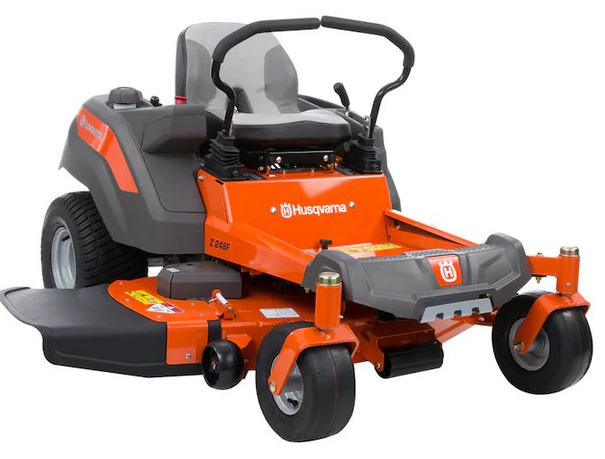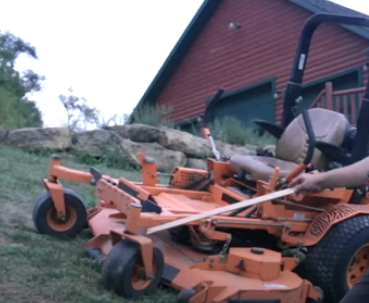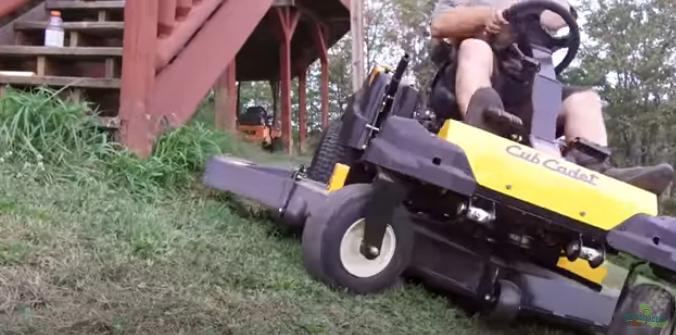Mowing hills and slopes can be tricky, especially using a zero-turn mower. The type of zero-turn mower you pick matters for how well it cuts and how easy it is to use. Steering wheel zero-turn mowers are better than the ones with lap bars, especially when working on hills.
Choosing the right zero-turn mower is essential to mow hillsides well. We discussed the differences between Lap Bar and Steering Wheel Zero Turn mowers and how their technology and design affect their work on challenging terrains.
Understanding the Challenge:
Before we start mowing hills, we must know how steep they are. Hills can be gentle slopes or steep inclines. Luckily, we can use our smartphones to determine how steep a hill is. There are easy-to-use apps that let you put your phone on the hill to see the angle in degrees.
Popular inclinometer apps:
- Simple inclinometer
- Clinometer + bubble level
- Bubble level meter
- Angle gradient clinometer
Experts use these apps to make a sure shot decision between lap bar mowers and steering wheel zero-turn mowers.
Lap Bar vs Steering Wheel Zero Turn Mowers
Performance of Lap Bar Zero-Turn on Hills:
Regular riding mowers with a standard lap bar need some help for cutting grass neatly on hills. The problem comes from the small front wheels, which make it hard to keep a straight line on slopes. This often leads to tearing up the grass. When the back tires have to go at an angle to keep the front wheels uphill, it creates ruts and grooves in the grass as the mower moves across the slope.

The Role of the Front Tires
The lap bar zero-turns are problematic because the front wheels don’t work well on hills. These wheels need to do more to help with stability or grip on slopes. The back tires have to do all the work to prevent slipping downhill. But because of this design problem, the back tires tear up the grass as they move across the slope. Since the front wheels can’t help on hills, they leave a lasting mark and damage the landscape.

Steering Wheel Zero-Turn:
Steering Wheel Zero-Turn mowers are like an excellent new version of lawn mowers that are different from the usual ones with lap bars. Instead of bars, they have a steering wheel connected to the front tires. It works through a unique synchro steer system, where the steering and the tires move together. This makes the mower turn smoothly, even on hills and stays stable. It’s a new and intelligent way to mow the lawn.

Performance of Steering Wheel Zero-Turn on Hills:
The Steering Wheel Zero-Turn is excellent because it helps prevent problems with the grass when you mow. Unlike mowers with lap bars, the steering wheel on this one can follow the slope of hills, making the grass look neat without any messy tracks left behind.
Here is the tabular form of the lap bar vs steering wheel of the turn lawn mower.
| Criteria | Lap Bar Zero Turn | Steering Wheel Zero Turn |
| Hill Climbing Ability | Relies solely on rear-wheel traction. | Mechanical linkage (synchro steer) aids uphill movement. |
| Front casters provide no traction support. | Transmissions assist when turning the steering wheel. | |
| The rear can slide downhill on slopes. | Improved stability when climbing hills. | |
| Maintaining Cut Quality | Drives along slopes at an angle. | It can drive parallel to the cut line. |
| Front casters uphill cause rear angle. | Synchro steer system eliminates turf tearing and rutting. | |
| Constant turf tearing and rutting occur. | Provides a cleaner and more polished cut on slopes. | |
| Handling and Control | Prone to losing traction and sliding downhill. | Excellent control and traction on slopes. |
| Front casters offer no braking or steering assistance. | Linked steering system aids smooth turns uphill or downhill. |
Best Zero Turn Mower With Steering Wheel
- DRIVES LIKE A CAR, TURNS ON A DIME – The EGO zero turn riding mower drives like a car with the added precision of a steering wheel with e-STEER technology opposed to traditional lap bars
- POWER OF GAS – This EGO riding mower is engineered to deliver the equivalent of 22 horsepower and reaches speeds up to 8 MPH
- CUTS UP TO 2.5 ACRES ON A SINGLE CHARGE – The EGO riding lawn mower cuts up to 2.5 acres on a single charge with four included 56V 12.0Ah batteries — add more batteries to cut 3, 4, 5, or as many acres as needed
- CUSTOMIZE YOUR RIDE – The zero turn mower includes an intuitive LCD interface to customize your mowing experience including three driving modes: Standard, Control, and Sport
- 10 CUTTING HEIGHT POSITIONS – Adjust cutting height on the EGO riding mower from 1.5 to 4.5 inches across 10 positions with 3-in-1 functionality including mulching, bagging, and side discharge from its 42-inch stamped steel deck
Advantages and Disadvantages of Lap Bar Zero Turn vs Steering Wheel Zero Turn:
Lap Bar Zero-Turn:
Advantages:
- Simple and intuitive control mechanism with lap bars.
- Typically more affordable, making them accessible to a range of users.
- High-end commercial models offer stability on slopes.
Disadvantages:
- Relies solely on rear-wheel traction for hill climbing.
- Front casters provide no braking or steering assistance.
- Maintenance of cut quality is challenging on slopes, leading to turf tearing.
Steering Wheel Zero Turn:
Advantages:
- The steering wheel provides precise and direct control.
- Mechanical linkage (synchro steer) aids uphill movement.
- It can drive parallel to the cut line, minimizing turf tearing on slopes.
- It offers excellent control and traction when turning on hills.
Disadvantages:
- The initial cost may be higher compared to some lap bar models.
- Potential complexity in the steering system.
- The availability of high-quality commercial models may be limited in some markets.
You can find here a zero-turn lawn mower with a lap bar of a Husqvarna model.
Now you know about lap bar vs steering wheel zero turn lawn mower. You may also like to read our article Comprehensive Buyers Guide for zero turn lawn mowers.
End Thought
When mowing on hilly slopes, using a steering wheel zero-turn mower can be a game-changer. It prevents damage to the grass and gives you more control. While other mowers with lap bars are good, the steering wheel zero-turn stands out because it’s more precise, stable, and provides a better quality cut. So, if you want to get the job done well on sloped lawns, this type of mower is a great choice.

Hi all, I’m Andy Haton, a professional expert in the space of zero-turn mower. I love to share my own experience with different zero-turn lawn mowers for yard care to help others achieve an efficient mowing experience.

